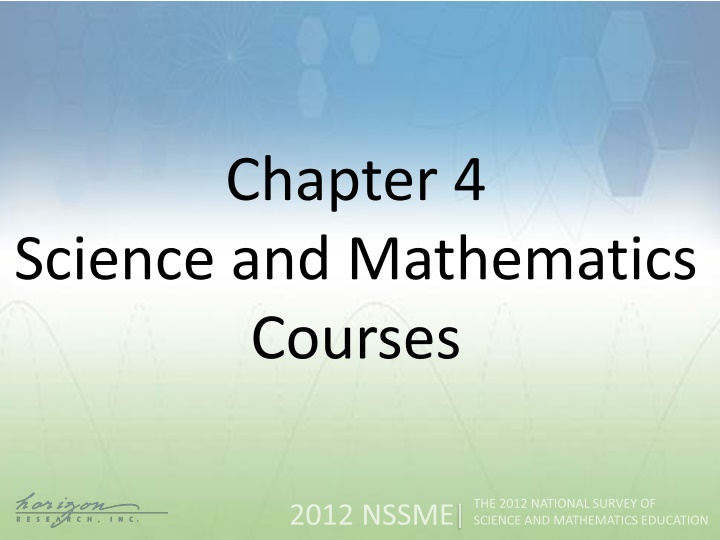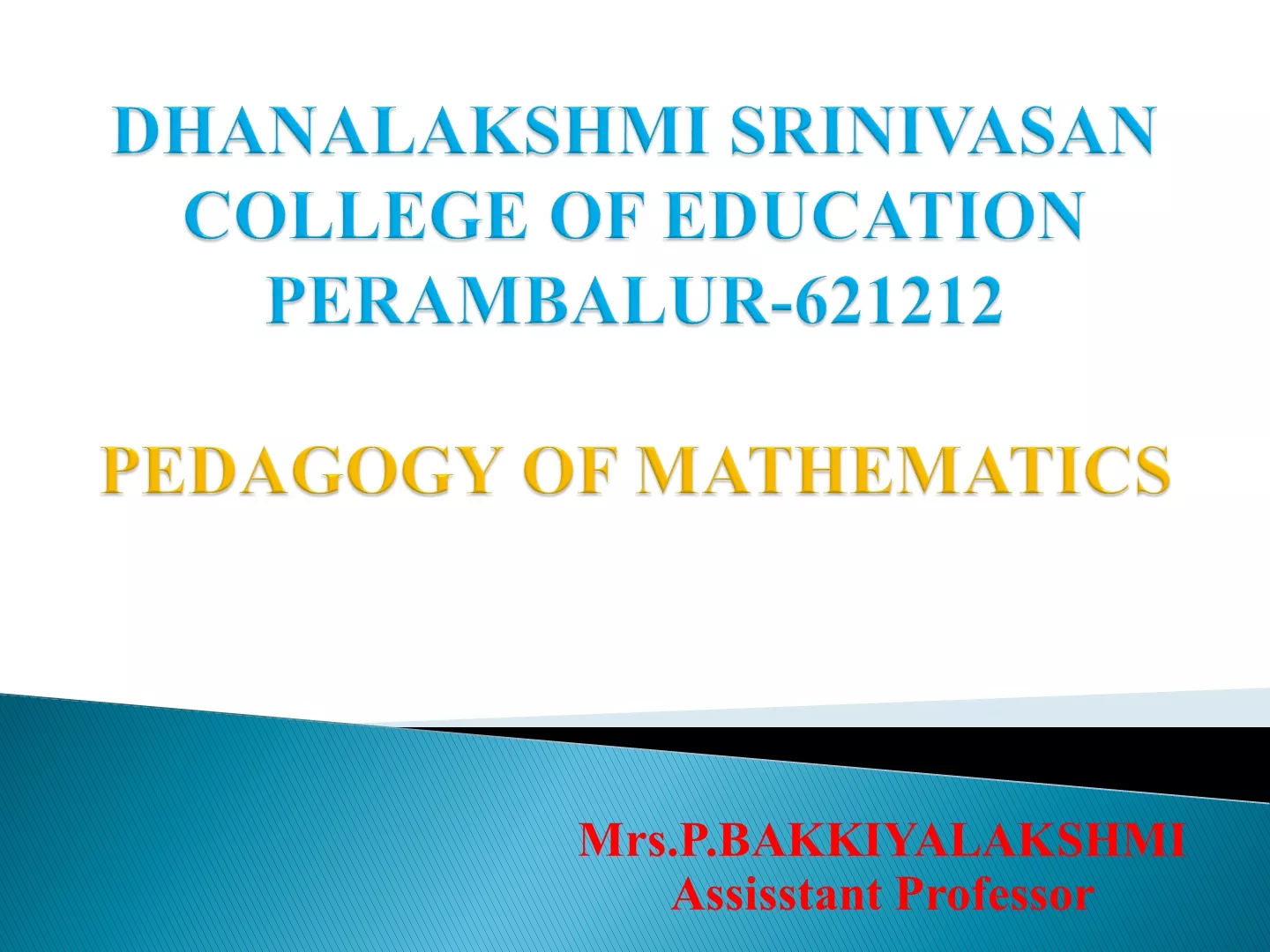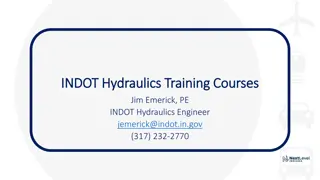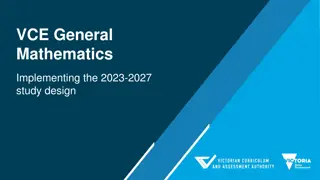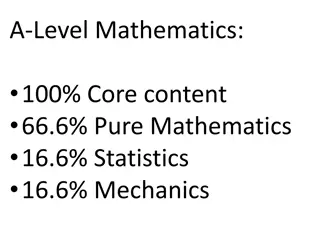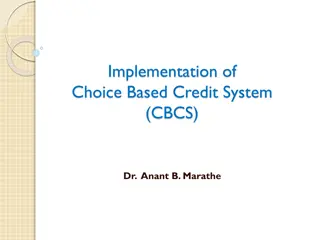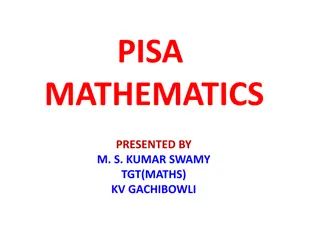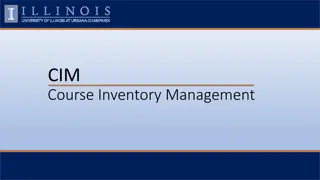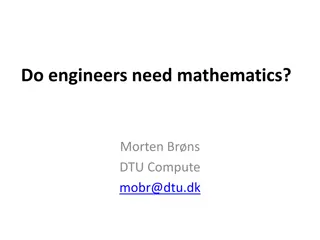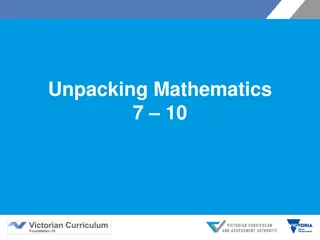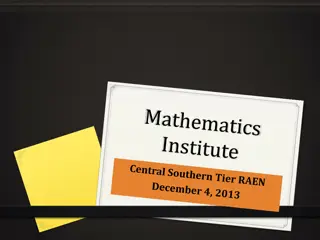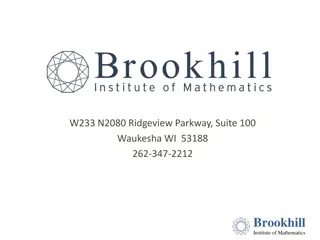Science and Mathematics Courses Overview
This content provides insights into the frequency and duration of science and mathematics instruction in elementary self-contained classes, along with data on the average number of minutes spent teaching various subjects. It also covers mathematics course offerings and middle schools' completion rates for Algebra 1 and Geometry. The information is presented through images and tables detailing these aspects of elementary and middle school education.
Download Presentation

Please find below an Image/Link to download the presentation.
The content on the website is provided AS IS for your information and personal use only. It may not be sold, licensed, or shared on other websites without obtaining consent from the author.If you encounter any issues during the download, it is possible that the publisher has removed the file from their server.
You are allowed to download the files provided on this website for personal or commercial use, subject to the condition that they are used lawfully. All files are the property of their respective owners.
The content on the website is provided AS IS for your information and personal use only. It may not be sold, licensed, or shared on other websites without obtaining consent from the author.
E N D
Presentation Transcript
Chapter 4 Science and Mathematics Courses
Time Spent in Elementary Mathematics Instruction
Original Data for Slide 5 (not for presentation) Table 4.1 Frequency with Which Self-Contained Elementary Classes Receive Science and Mathematics Instruction, by Subject Percent of Classes Mathematics 99 1 1 98 2 0 Grades K 3 All/Most days, every week Three or fewer days, every week Some weeks, but not every week Grades 4 6 All/Most days, every week Three or fewer days, every week Some weeks, but not every week No grades 4 6 teachers in the sample selected this response option. Thus, it is not possible to calculate the standard error of this estimate. (0.4) (0.3) (0.3) (0.9) (0.9) ---
Frequency with Which Self-Contained Elementary Classes Receive Mathematics Instruction 99 98 100 80 Percent of Classes 60 40 20 2 1 1 0 0 Grades K 3 Grades 4 6 All/Most days, every week Three or fewer days, every week Some weeks, but not every week
Original Data for Slide 7 (not for presentation) Table 4.2 Average Number of Minutes per Day Spent Teaching Each Subject in Self-Contained Classes, by Grades Number of Minutes Grades K 3 89 (1.7) 54 (1.0) 19 (0.5) 16 (0.4) Reading/Language Arts Mathematics Science Social Studies Only teachers who indicated they teach reading/language arts, mathematics, science, and social studies to one class of students were included in these analyses. Grades 4 6 83 (2.2) 61 (1.4) 24 (0.9) 21 (0.8)
Average Number of Minutes Spent Teaching Subjects in Self-Contained Classes, by Grades 100 89 83 80 61 Number of 54 Minutes 60 40 24 21 19 16 20 0 Grades K 3 Grades 4 6 Reading/Language Arts Mathematics Science Social Studies
Mathematics Course Offerings
Original Data for Slide 10 (not for presentation) Table 4.9 Middle Schools with Various Percentages of 8th Graders Completing Algebra 1 and Geometry Prior to 9th Grade Percent of Schools Algebra 1 25 (3.5) 4 (1.0) 10 (1.7) 14 (1.7) 11 (2.4) 9 (2.3) 7 (2.1) 4 (1.5) 6 (1.9) 2 (0.9) 9 (1.8) Geometry 72 13 7 2 3 2 2 0 1 0 0 0 percent 1 10 percent 11 20 percent 21 30 percent 31 40 percent 41 50 percent 51 60 percent 61 70 percent 71 80 percent 81 90 percent Over 90 percent No middle schools in the sample were in this category. Thus, it is not possible to calculate the standard error of this estimate (2.5) (1.4) (1.4) (0.5) (1.9) (1.0) (0.9) --- (0.5) --- (0.1)
Middle Schools with Percentages of 8th Grade Students Completing Algebra 1 and Geometry Prior to 9th Grade 80 72 60 Percent of Schools 40 28 26 25 21 20 20 5 2 0 Algebra 1 Geometry 0 percent 1 25 percent 26 50 percent Over 50 percent
Original Data for Slides 1214 (not for presentation) Table 4.10 Average Percentage of 8th Graders Completing Algebra I and Geometry Prior to 9th Grade, by Equity Factors Percent of 8th Grade Students Algebra 1 46 (6.1) 26 (4.5) 31 (5.9) 28 (3.9) 33 (4.6) 34 (4.1) 39 (4.0) 42 (3.1) 27 (4.4) 38 (3.2) 42 (4.7) 31 (4.4) 42 (6.2) 27 (3.4) 46 (6.3) Geometry 13 2 2 6 4 7 5 5 3 5 7 4 7 4 6 Percent of Students in School Eligible for FRL Lowest Quartile Second Quartile Third Quartile Highest Quartile School Size Smallest Schools Second Group Third Group Largest Schools Community Type Rural Suburban Urban Region Midwest Northeast South West (3.4) (0.6) (0.8) (1.9) (1.4) (2.3) (1.8) (0.7) (1.7) (1.5) (1.9) (1.5) (2.9) (1.4) (2.2)
8th Grade Students Completing Algebra 1 and Geometry Prior to 9th Grade, by Percentage of Students in School Eligible for Free/Reduced-Price Lunch 100 Percent of 8th Grade Students 80 60 46 40 31 28 26 20 13 6 2 2 0 Lowest Poverty Schools Second Quartile Third Quartile Highest Poverty Schools Algebra I Geometry
8th Grade Students Completing Algebra 1 and Geometry Prior to 9th Grade, by School Size 100 Percent of 8th Grade Students 80 60 42 39 40 34 33 20 7 5 5 4 0 Smallest Schools Second Group Third Group Largest Schools Algebra I Geometry
8th Grade Students Completing Algebra 1 and Geometry Prior to 9th Grade, by Community Type 100 Percent of 8th Grade Students 80 60 42 38 40 27 20 7 5 3 0 Rural Suburban Urban Algebra I Geometry
Original Data for Slide 16 (not for presentation) Table 4.11 High Schools Offering Various Mathematics Courses Percent of Schools 78 (3.2) 99 (0.7) 90 (3.7) 94 (3.5) 85 (3.8) 76 (4.0) Non-college prep (e.g., Remedial Math, General Math, Consumer Math) Formal/College-prep Level 1 (e.g., Algebra 1, Integrated Math 1) Formal/College-prep Level 2 (e.g., Geometry, Integrated Math 2) Formal/College-prep Level 3 (e.g., Algebra 2, Algebra and Trigonometry) Formal/College-prep Level 4 (e.g., Pre-Calculus, Algebra 3) Courses that might qualify for college credit (e.g., AP Calculus, AP Statistics)
High Schools Offering Various Mathematics Courses 99 100 94 90 85 78 76 80 Percent of Schools 60 40 20 0 Non-college Prep Level 1 Level 2 Level 3 Level 4 College Level
Original Data for Slide 18 (not for presentation) Table 4.12 Access to AP Mathematics Courses Percent of High Schools Offering 52 (3.5) 27 (2.1) 23 (2.5) Percent of High School Students with Access 81 59 47 AP Calculus AB AP Statistics AP Calculus BC (1.6) (1.9) (2.1)
Access to AP Mathematics Courses 100 81 80 59 60 52 47 AP Calculus AB AP Statistics 40 27 AP Calculus BC 23 20 0 Percent High Schools Offering Percent High School Students with Access
Original Data for Slide 20 (not for presentation) Table 4.13 Number of AP Mathematics Courses Offered at High Schools Percent of Schools 49 20 17 14 0 courses 1 course 2 courses 3 courses Only schools that responded about each AP mathematics course are included in this analysis. (3.5) (2.6) (2.7) (1.3)
Number of AP Mathematics Courses Offered at High Schools 60 49 Percent of Schools 40 20 20 17 14 0 0 courses 1 course 2 courses 3 courses
Original Data for Slides 2224 (not for presentation) Table 4.14 Average Number of AP Mathematics Courses Offered at High Schools, by Equity Factors Average Number of Courses 1.4 1.1 0.8 0.7 0.6 0.9 1.6 2.1 0.6 1.2 1.3 0.8 1.3 1.0 1.0 Percent of Students in School Eligible for FRL Lowest Quartile Second Quartile Third Quartile Highest Quartile School Size Smallest Schools Second Group Third Group Largest Schools Community Type Rural Suburban Urban Region Midwest Northeast South West (0.2) (0.2) (0.1) (0.1) (0.1) (0.1) (0.1) (0.1) (0.1) (0.1) (0.2) (0.1) (0.2) (0.1) (0.1)
Average Number of AP Mathematics Courses Offered at High Schools, by Percentage of Students in School Eligible for Free/Reduced-Price Lunch 2.5 Average Number of Courses 2 1.4 1.5 1.1 1 0.8 0.7 0.5 0 Lowest Poverty Schools Quartile of Schools Based on Percentage of Students Eligible for Free/Reduced-Price Lunch Second Quartile Third Quartile Highest Poverty Schools
Average Number of AP Mathematics Courses Offered at High Schools, by School Size 2.5 2.1 Average Number of Courses 2 1.6 1.5 0.9 1 0.6 0.5 0 Smallest Schools Second Group Quartile of Schools Based on School Size Third Group Largest Schools
Average Number of AP Science Courses Offered at High Schools, by Community Type 2.5 Average Number of Courses 2 1.5 1.3 1.2 1 0.6 0.5 0 Rural Suburban Community Type Urban
Original Data for Slides 2627 (not for presentation) Table 4.15 Mathematics Programs and Practices Currently Being Implemented in High Schools Percent of Schools Calculus courses (beyond pre-Calculus) offered this school year or in alternating years, on or off site Probability and/or statistics course offered Concurrent credit/dual enrollment courses offered this school year or in alternating years Algebra 1 course offered over two years or as two separate block courses (e.g., Algebra A and Algebra B) Students go to a college or university for mathematics courses Mathematics courses offered by telecommunications Students go to a Career and Technical Education Center for mathematics instruction Students go to another K 12 school for mathematics courses 76 41 40 (3.5) (3.0) (3.4) 37 31 24 11 5 (3.7) (3.0) (3.3) (1.6) (2.3)
Mathematics Programs and Practices Currently Being Implemented at High Schools Calculus courses offered, on or off site 76 Probability and/or statistics courses offered 41 Concurrent credit/dual enrollment courses 40 Algebra 1 courses offered over 2 years or 2 separate block courses 37 0 20 40 60 80 100 Percent of Schools
Mathematics Programs and Practices Currently Being Implemented at High Schools Students go to college or university for instruction 31 Mathematics courses offered by telecommunications 24 Students go to a Career or Technical Education Center for instruction 11 Students go to another K 12 school for instruction 5 0 20 40 60 80 100 Percent of Schools
Other Characteristics of Mathematics Classes
Original Data for Slide 30 (not for presentation) Table 4.19 Prior-Achievement Grouping in Classes, by Subject and Grade Range Percent of Classes Middle 27 24 24 26 Mathematics Classes Mostly low achievers Mostly average achievers Mostly high achievers A mixture of levels Elementary 12 35 9 45 High 24 28 26 22 (1.0) (1.6) (0.9) (1.5) (1.8) (1.8) (1.7) (1.8) (1.1) (1.5) (1.1) (1.1)
Prior Achievement Grouping in Mathematics Classes, by Grade Range 60 45 Percent of Classes 40 35 28 27 26 26 24 24 24 22 20 12 9 0 Elementary Middle High Mostly low achievers Mostly average achievers Mostly high achievers A mixture of levels
Original Data for Slides 3233 (not for presentation) Table 4.23 Average Percentages of Female and Non-Asian Minority Students in Courses, by Grade Range and Course Type Mathematics Non-Asian Minority 40 (1.5) 37 (1.8) 31 (1.1) 45 (3.3) 39 (2.2) 31 (2.0) 27 (2.3) 22 (2.0) 17 (2.0) Female 47 (0.5) 48 (0.6) 48 (0.7) 42 (1.4) 48 (1.1) 50 (1.5) 51 (1.4) 48 (2.1) 48 (1.7) Grades Elementary Middle High High School Mathematics Courses Non-college prep Formal/College-prep Level 1 Formal/College-prep Level 2 Formal/College-prep Level 3 Formal/College-prep Level 4 Courses that might qualify for college credit
Average Percentage of Female Students in High School Mathematics Courses, by Course Type 100 80 Average Percent of Students 60 51 50 48 48 48 42 40 20 0 Non-college Prep Level 1 Level 2 Level 3 Level 4 College Level
Average Percentage of Historically Underrepresented Students in High School Mathematics Courses, by Course Type 100 Average Percent of Students 80 60 45 39 40 31 27 22 17 20 0 Non-college Prep Level 1 Level 2 Level 3 Level 4 College Level
